Outline of JWA
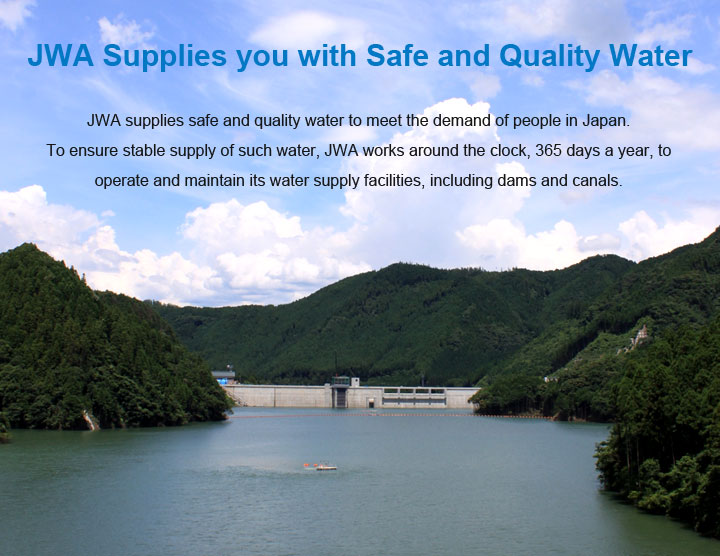
Our Mission
- [1]Stably supplying safe and quality water
- [2]Preventing and mitigating flood hazards
- [3]Preparing for crises
- [4]Ensuring facility integrity
- [5]Developing facilities in a systematic and appropriate manner
- [6]Conserving natural environment
- [7]Promoting international cooperation
- [8]Support Activities by Japan Water Agency
[1]Stably supplying safe and quality water
Stable water supply (Water supply from dams)
The river flow condition changes depending on the rainfall. When it decreases due to low precipitation, for example, the dam managed by JWA releases water from the reservoir to the river downstream to ensure that the necessary amount of water can be taken stably from the intakes. JWA also supplies the necessary amount of water to facilitate water transportation, fisheries, and conserve the river environment.
(Water Supply for different purposes from canal facilities) JWA meticulously operates, maintains, and manages its canals that extend approx. 3,030 km in total length.
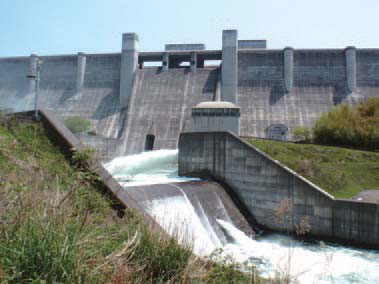
Water supplies to water users from the Hinachi Dam
(Water Supply for different purposes from canal facilities)
JWA meticulously operates, maintains and manages its canals that extend approx. 3,030 km in total length.
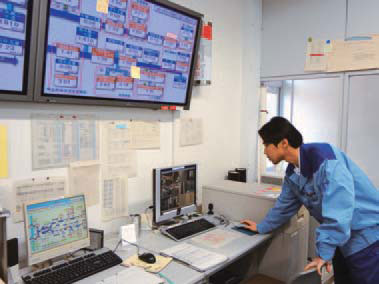
An operator at Gunma Canal facilities
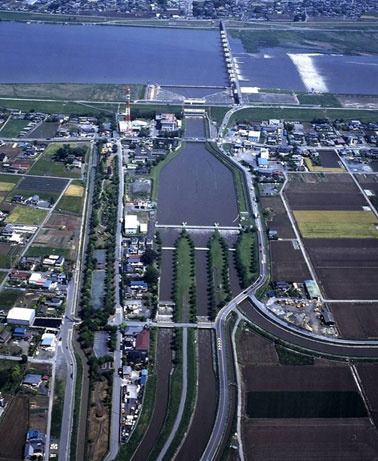
Taking water from the Tone River at the Tone Barrage
Safe and quality water supply
JWA conducts water quality surveys and facility patrols to monitor day-to-day water quality. It also addresses eutrophication and water turbidity with effective use of its facilities.
In the event of pipeline leakage or a water quality hazard due to an oil spill in a river or canal, JWA takes prompt action to prevent the damage from spreading and notify water users for information sharing.
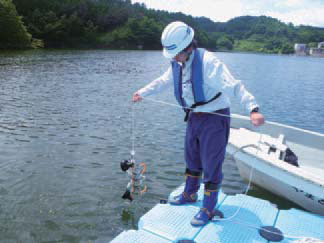
Water survey above the Nunome Dam
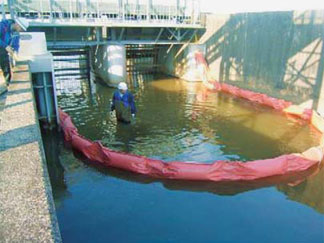
An oil fence is installed across the Kisogawa Canal to address a water quality hazard
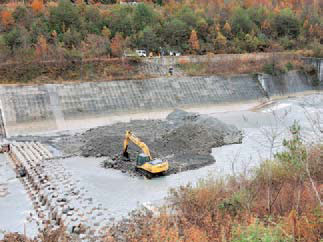
Removal of volcanic ashes from Mt. Ontake (Makio Dam-Aichi Canal)
[2]Preventing and mitigating flood hazards
Flood control with dams
Dams perform an essential function of storing river water that increases rapidly in volume due to heavy rain and regulate discharges downstream (flood control function). Weirs and barrages raise water levels with their gate shut down in normal times. At the time of the flood, however, the gate is opened to allow excessive river water to flow downstream safely.
When a heavy rain that may cause floods is expected, JWA accurately assess weather information and river flow condition and operate its dams, weirs/barrages, and facilities accordingly.
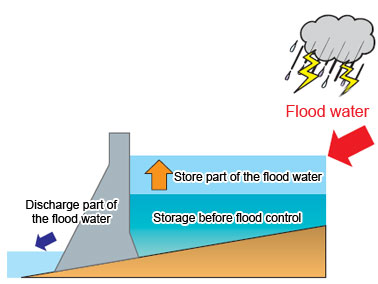
Conceptual rendering of flood control
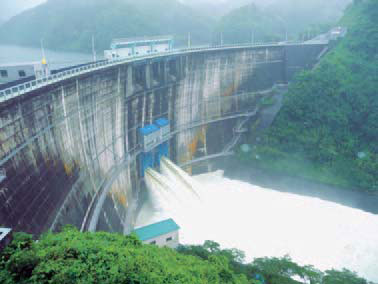
Flood control at the Shorenji Dam
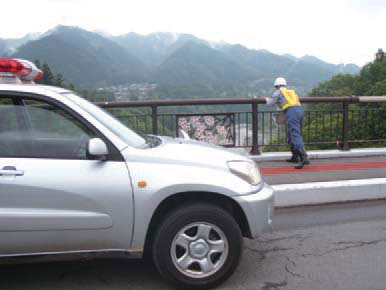
Facility patrol at the Takizawa Dam
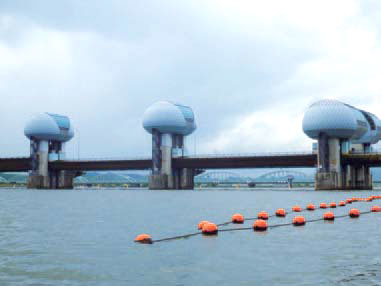
The gate at the Nagaragawa Estuary Barrage is widely opened to discharge flood water
[3]Preparing for crises
Better seismic performance
JWA keeps improving the seismic performance of its facilities, thereby enhances public confidence in its security. To this end, JWA checks their seismic performance and assess their risks relating to major earthquakes. Based on the findings of such checks and assessments, JWA is conducting seismic measures systematically.
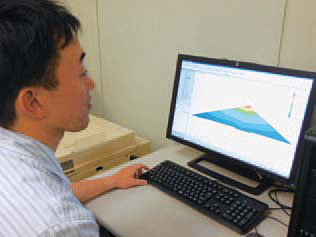
Checking seismic performance
(Resources Engineering Department)
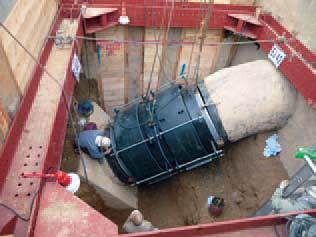
Seismic engineering
(replacing a flexible pipe)
(Fukuoka Headrace)
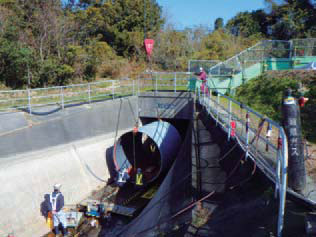
Bracing for an possible major earthquake
(Inserting a steel pipe into the existing siphon)
(Toyogawa Canal)
Routine training for major disasters
JWA works with the central government, water users, the police, fire and disaster management authorities and other institutions concerned to conduct flood response exercises and earthquake and disaster management drills regularly to prepare for floods, major earthquakes, and other natural disasters, as well as water quality hazards.
JWA also has a stockpile of steel pipes, pump trucks, and other equipment and materials in preparation for any contingency on its canal facilities.
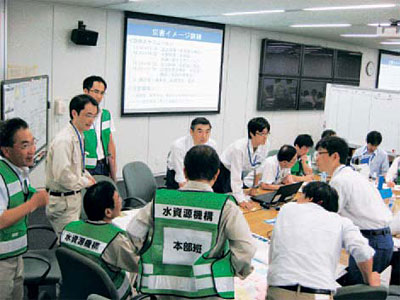
Earthquake and disaster management drill
(Headquarters)
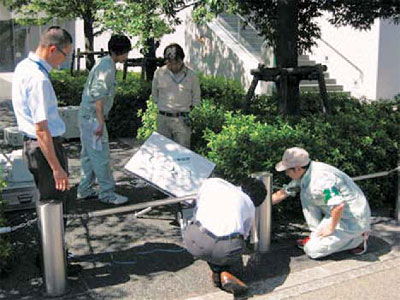
Installation practice for central disaster emergency communications network equipment
(Headquarters)
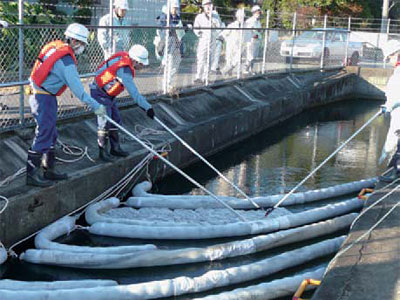
Water quality accident response drill
(Gunma Canal)
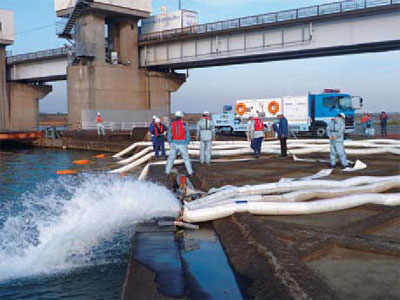
Pump truck water-supply drill
(Tone Canal)
[4]Ensuring facility integrity
Facility inspection and maintenance
JWA works to conserve and manage its facilities through routine patrol, inspection and maintenance. On dam reservoirs, it collects driftwood and solid waste using work-boats.
JWA also strives to find any malfunction of its canal facilities, and leakage from them as early as possible. It promptly repairs any leak from such facilities so that the water supply can be smooth without interruptions.
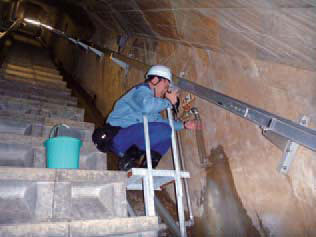
Measuring the leakage inside the dam body
(Shimokubo Dam)
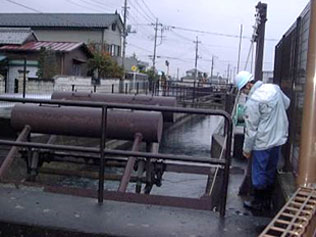
Routine patrol of canal facilities
(Tone Canal)
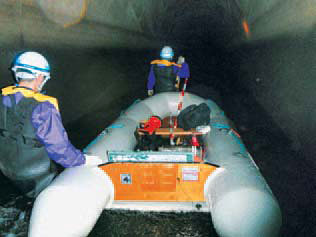
Inspecting the inside of a tunnel
(Kasumigaura Canal)
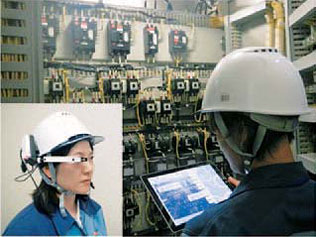
Facility operation support, using a head-mounted tablet display (Trial run) (Lake Biwa Development)
Stock management of canals and other facilities
JWA conducts the routine inspection, maintenance and regular functional diagnostic study to accurately assess the state of each facility and share the information on their risks and their effects to water users to take necessary measures appropriately, extend the facility life, and reduce its life-cycle costs.
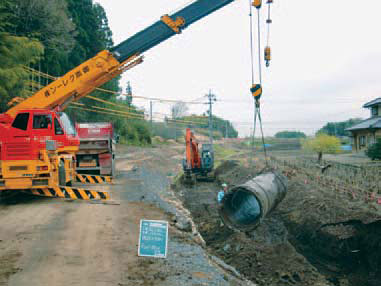
Replacing a branch pipeline at the Kisogawa Canal
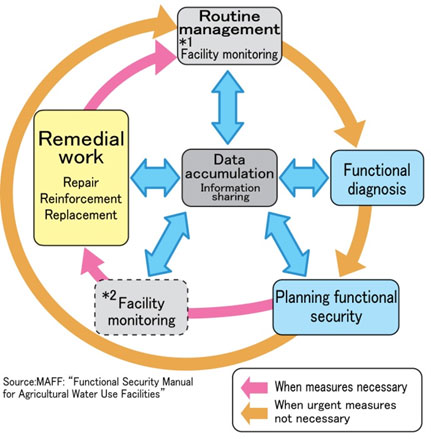
*1 Continual facility monitoring as part of the routine management
(The resulted data are used for functional analysis and planning of functional security.)
*2 Facility monitoring regularly conducted to enhance the quality of functional security plan and to find the right timing of remedial work
(The resulted data are used for functional analysis and planning of functional security.)
*2 Facility monitoring regularly conducted to enhance the quality of functional security plan and to find the right timing of remedial work
Extending the life of dams
To secure the safety and long life of functions of dams, JWA conducts periodical inspections every three years, and for the dams with 30 years of services since the start of management, JWA implements the comprehensive inspection of each of them. Based on the result of that inspection, JWA formulates the plan that prescribes a medium and long-term maintenance and management policy to extend the life of the dam, and carries out the systematic maintenance and management work.
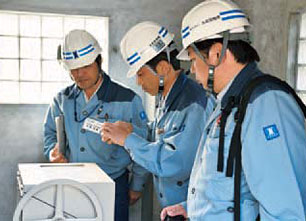
Equipment check as part of dam's regular inspection
(Muroo Dam)
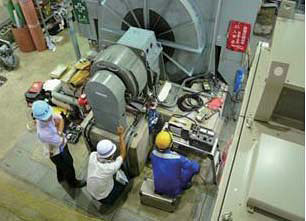
Inspection of the hydropower plant
(Hitokura Dam)
[5]Developing facilities in a systematic and appropriate manner
Construction and reconstruction of dams, canals and other facilities
JWA constructs, and reconstructs dams, canals, and other facilities systematically for stable water supply.
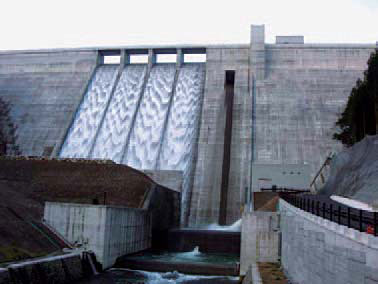
Oyama Dam construction project
(completed in 2012)
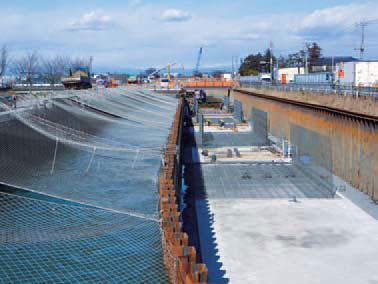
Musashi Canal reconstruction project
(Change to double-way canal)
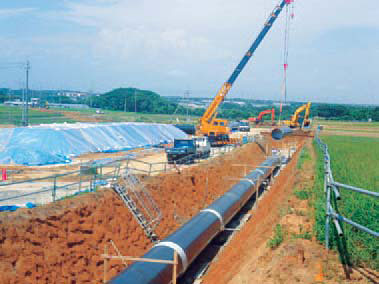
Toyogawa Canal Project Stage II
(Renewal of the canal)
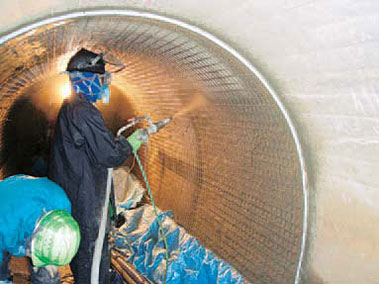
Ryochiku-heiya Canal Stage II
(Reinforcement of inner tunnel surface)
[6]Conserving the natural environment
Conservation of the natural environment
JWA engages in the environmental survey, revegetation, and vibration and noise pollution control to conserve the natural environment, including the local flora and fauna, ecosystems, and landscapes. In addition, as a member of the local community, it engages in environmental conservation activities proactively.
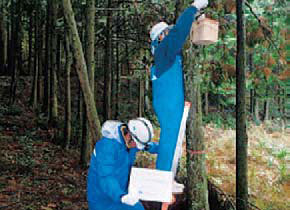
Environmental Survey Installation of dormice
(Koishibaragawa Dam)
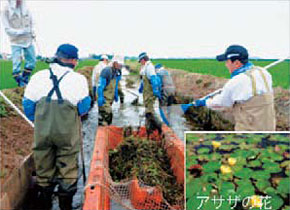
Participation in floating hearts preservation activities
(Lake Biwa Development)
(Reinforcement of inner tunnel surface)
Improvement of the environment of downstream river
We are working on the improvement of river environment for the fish and other river creatures, providing a large amount of sand and gravel to the downstream rivers of the dams and discharging water within a short time to flush the mud and mosses adhered to the gravel in the river away and refresh them. As a result of such measures, in the case of Hitokura Dam of Kawanishi City, Hyogo Pref., there were increasing number of small creatures on the bottom of the river such as may fly, stonefly, and caddisfly and freshwater fish by about 5 times compared with the days before such river refreshment measures.
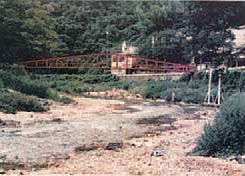
1. In 1976, when the river condition was good.
(Gravel and sand spread on the surface.)
(Gravel and sand spread on the surface.)
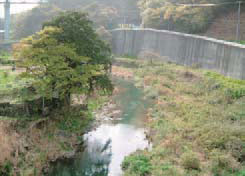
2. In 2002, about 20 years passed since management start.
The river condition was bad. Gravel and sand are gone and grasses and bushes were growing.
The river condition was bad. Gravel and sand are gone and grasses and bushes were growing.
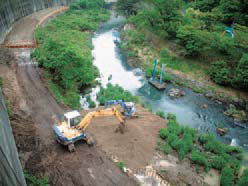
3. In 2003, gravel and sand were thrown in with a heavy machine
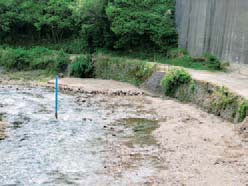
4. In 2015, when the river condition is good. (Coming closer to the condition before dam construction)
An example of the improvement work of downstream river environment of Hitokura Dam
[7]Promoting international cooperation
Network of Asian River Basin Organizations (NARBO)
[Other Works]
Strengthening Coordination with Local Municipalities Concerned and Local People
JWA strives for the social exchanges between the people of upstream and downstream areas to deepen the coordination with the water source areas where they show deep understanding and cooperation in organizing and managing the dam facilities and also with the water users downstream.
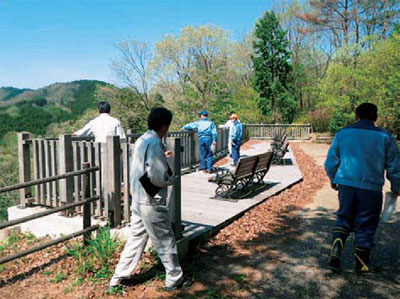
Safety inspection with local municipality staff
(Muroo Dam)
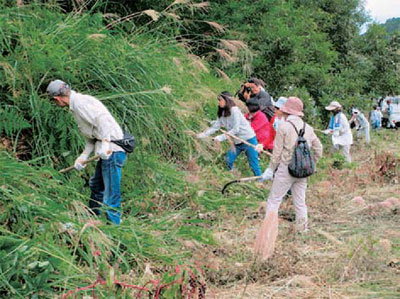
Underbrush clearing activity with people of upstream and downstream areas
(Oyama Dam)
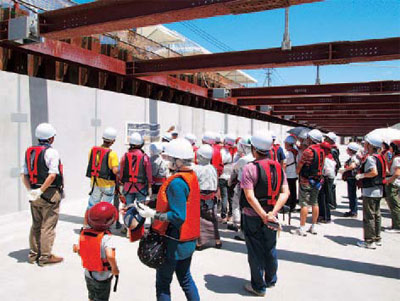
Facility site tour
(Musashi Canal)
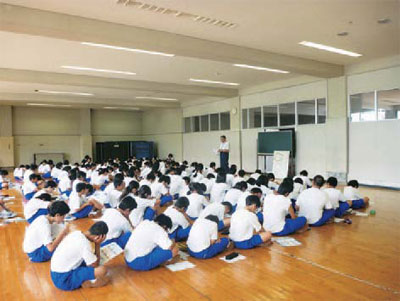
A lecture at the local high school
(Tokuyama Dam)
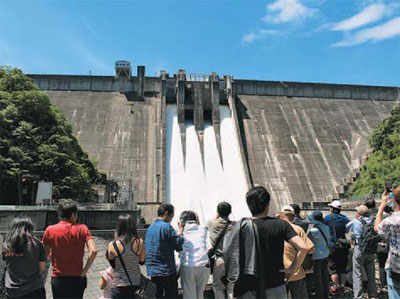
Gate inspection discharge-opening to the public
(Shimokubo Dam)
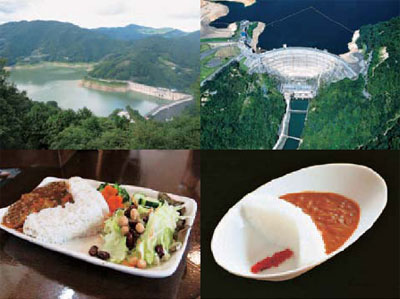
"Dam Curry and Rice" served at a diner near the dam
(Left: Shimokubo Dam, Right: Yagisawa Dam)

 Sitemap
Sitemap See more >
See more > 